Odin Chandelier

abchome > Ceiling lamp
The grand and magnificent Odin Chandelier is crafted from 400 glass rods around a double tier of antiqued brass, imposing and very stylish all at the same time. Make a statement in any space as the centerpiece of the room. All Pooky lighting is exclusively available in the U.S. at abc carpet & home. Originally launched in the UK, Pooky is all about bringing the magic of stunning, decorative lighting to your home. Note: self-assembly required. If you were tasked with making over the banqueting halls in Valhalla then maybe this could be the kind of vibe you’d be after. We’ve scaled it down to fit more earthly dwellings but it still has over 400 glass rods around a double tier of brass and is grand, imposing and very stylish all at the same time. A magnificent centrepiece over a dining table or a kitchen island. A show-stealer, no mistake. Comes with a certain level of self-assembly required.Dimensions: 39.25" W x 39.25" D x 11.75" H Brand: Pooky Category: Lighting Sub-Category: Lighting > Pendants + Chandeliers Specifications: Indoor use only Dimmerable Chain length 79" Minimum drop 17.75" Ceiling canopy diameter 5.5" Self assembly is required E26 Care: Gently dust with a soft cloth. Material: Glass
SETAREH GLASS LARGE
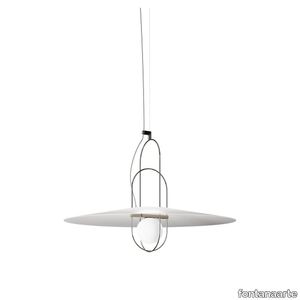
fontanaarte > Ceiling lamp
This is the name of the family of lighting fixtures that Francesco Librizzi, a young Sicilian architect working in Milan, has designed for the first time for FontanaArte. Setareh was born of the idea of giving form to light. The lamp is composed of a sphere magically suspended within a thin metal structure. The play of circular masses and trajectories generates a balanced design of gravitational dynamics. The light from the sphere is diffused into the surrounding space, illuminating the frame. The reflections of the metal render the luminous field visible, space influenced by light, by its aura. The result is a collection of lighting elements, available in tabletop and suspension versions, of extraordinary poetic grace. Setareh takes on new dimensions: elongated, with either two or three spherical elements that work separately or together. Its vocation is the illumination of large spaces, with double-height ceilings or otherwise ample enough to accomodate expansive compositions of multiple elements. A firmament of Setareh, ‘star’ in the ancient Farsi language.
T3 Table Lamp
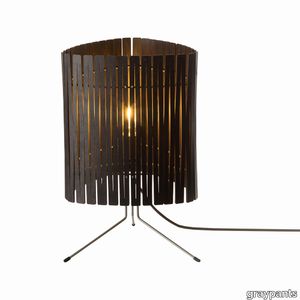
graypants > Ceiling lamp
Inspired by tried and true handcrafting techniques, the Kerflights series is precision built to accommodate any situation. Durable powder-coated steel wire frames provide a distinct shape and character for each lamp. The shades are crafted from FSC-certified high quality plywood with a unique kerf pattern cut into the panels allowing for intriguing patterns to be cast onto walls and table surfaces. The magic in the Kerflights series lies within the flexibility of the design. The shade panels are swappable and reversible, allowing for future possibilities over their long lives.
Multicolored Transitional Silk Rug
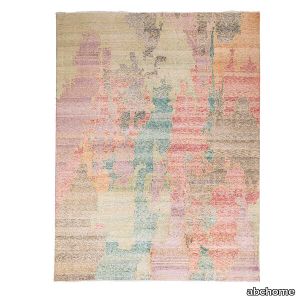
abchome > Carpet
<!-- td {border: 1px solid #cccccc;}br {mso-data-placement:same-cell;} --> This contemporary rug designs is interpreted from modern textile; handmade from organic silk it features an abstract design in a palette of light blue, cerulean, gray and ivory hues. The yarn is directly spun from cocoon; the natural yarn is then dyed & then woven into the rug. The magic happens in washing when the natural coarse silk is treated to create extraordinary shiny and silky texture rusting in one- of a kind masterpiece. Soft and shapeshifting, even the most particular eyes will swoon; a dream rug for living rooms and bedrooms in need of an elevated & sustainable centerpiece.
TROPICO PICCOLA

fontanaarte > Wall lamp
The "shape of light" is the central theme of this project by Gabriele and Oscar Buratti, which began with the Equatore family of lamps, presented in 2017 and now expanded to include other finishes, and continues with the new Meridiano and Tropico. Forms of glass and metal that collect, contain and diffuse light in space. Passing between opaline, coloured and transparent layers, emphasised by the refined curves and the magic of blown glass, the light is free to create surprising and fascinating effects, patterns and moods. Tropico is a spherical cap of opaque opaline glass, flattened and fixed by a large mirrored metal boss. The family comprises wall/ceiling and table versions, both available in three different sizes.
SETAREH SMALL
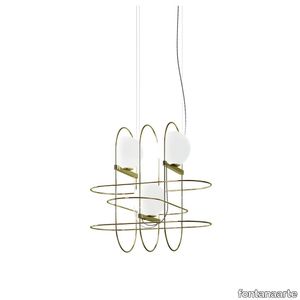
fontanaarte > Ceiling lamp
This is the name of the family of lighting fixtures that Francesco Librizzi, a young Sicilian architect working in Milan, has designed for the first time for FontanaArte. Setareh was born of the idea of giving form to light. The lamp is composed of a sphere magically suspended within a thin metal structure. The play of circular masses and trajectories generates a balanced design of gravitational dynamics. The light from the sphere is diffused into the surrounding space, illuminating the frame. The reflections of the metal render the luminous field visible, space influenced by light, by its aura. The result is a collection of lighting elements, available in tabletop and suspension versions, of extraordinary poetic grace. Setareh takes on new dimensions: elongated, with either two or three spherical elements that work separately or together. Its vocation is the illumination of large spaces, with double-height ceilings or otherwise ample enough to accomodate expansive compositions of multiple elements. A firmament of Setareh, ‘star’ in the ancient Farsi language.
Friday dining chair with arms - sand frame - black back - Sydney Light Grey - 91

fest-amsterdam > Chair
Dont let its slim appearance fool you. This elegant Friday Dining Chair is solid as a rock. The frame consists of high-quality recycled steel while its back is made of steam-bent solid wood. This design dining chair is available with a small or wide back and its seat comes in black or over 100 fabrics. Choose your favourite and let our craftsmen work their magic
Friday Dining chair no arms - black frame - natural back - Cube Light green - 55
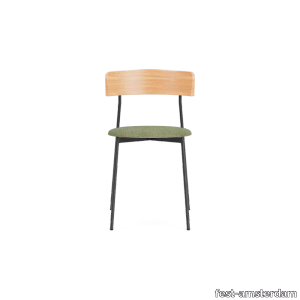
fest-amsterdam > Chair
Dont let its slim appearance fool you. This elegant Friday Dining Chair is solid as a rock. The frame consists of high-quality recycled steel while its back is made of steam-bent solid wood. This design dining chair is available with a small or wide back and its seat comes in black or over 50 fabrics. Choose your favourite and let our craftsmen work their magic
EQUATORE SMALL
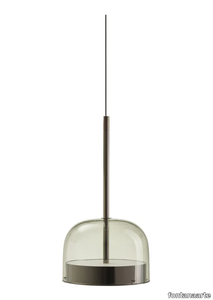
fontanaarte > Ceiling lamp
Equatore is a contemporary reinterpretation of the classic lamp with a glass shade. While the traditional abat-jour uses the shade to contain the light source within, in this family of lamps the shade is paradoxically and suggestively empty, with the light being generated by two luminous discs placed inside a central metal band, visible on the shade, that evokes the line of the equator. The light produced by the Leds, thanks to internal screens arranged in layers, is distributed regularly across the surface of the discs, magically illuminating them. The bottom disc directs the light output downward, the upper one illuminates the glass cap for a soft, diffused light. Available in table, floor and ceiling models, in two sizes and two colors: a cooler version in gray with a dark chrome frame, and a warmer version with a transparent dove gray cap and a copper-colored frame.
D6 Drum Pendant
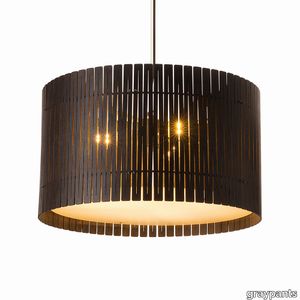
graypants > Ceiling lamp
Inspired by tried and true handcrafting techniques, the Kerflights series is precision built to accommodate any situation. Durable powder-coated steel wire frames provide a distinct shape and character for each lamp. The shades are crafted from FSC-certified high quality plywood with a unique kerf pattern cut into the panels allowing for intriguing patterns to be cast onto walls and table surfaces. The magic in the Kerflights series lies within the flexibility of the design. The shade panels are swappable and reversible, allowing for future possibilities over their long lives.
EQUATORE MEDIUM
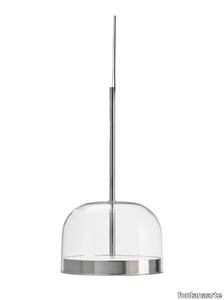
fontanaarte > Ceiling lamp
Equatore is a contemporary reinterpretation of the classic lamp with a glass shade. While the traditional abat-jour uses the shade to contain the light source within, in this family of lamps the shade is paradoxically and suggestively empty, with the light being generated by two luminous discs placed inside a central metal band, visible on the shade, that evokes the line of the equator. The light produced by the Leds, thanks to internal screens arranged in layers, is distributed regularly across the surface of the discs, magically illuminating them. The bottom disc directs the light output downward, the upper one illuminates the glass cap for a soft, diffused light. Available in table, floor and ceiling models, in two sizes and two colors: a cooler version in gray with a dark chrome frame, and a warmer version with a transparent dove gray cap and a copper-colored frame.
EQUATORE MEDIUM

fontanaarte > Floor lamp
Equatore is a contemporary reinterpretation of the classic lamp with a glass shade. While the traditional abat-jour uses the shade to contain the light source within, in this family of lamps the shade is paradoxically and suggestively empty, with the light being generated by two luminous discs placed inside a central metal band, visible on the shade, that evokes the line of the equator. The light produced by the Leds, thanks to internal screens arranged in layers, is distributed regularly across the surface of the discs, magically illuminating them. The bottom disc directs the light output downward, the upper one illuminates the glass cap for a soft, diffused light. Available in table, floor and ceiling models, in two sizes and two colors: a cooler version in gray with a dark chrome frame, and a warmer version with a transparent dove gray cap and a copper-colored frame.
EQUATORE SMALL
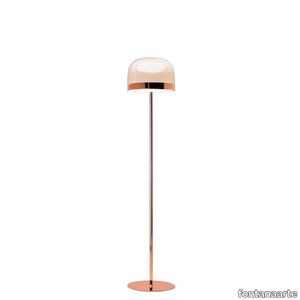
fontanaarte > Floor lamp
Equatore is a contemporary reinterpretation of the classic lamp with a glass shade. While the traditional abat-jour uses the shade to contain the light source within, in this family of lamps the shade is paradoxically and suggestively empty, with the light being generated by two luminous discs placed inside a central metal band, visible on the shade, that evokes the line of the equator. The light produced by the Leds, thanks to internal screens arranged in layers, is distributed regularly across the surface of the discs, magically illuminating them. The bottom disc directs the light output downward, the upper one illuminates the glass cap for a soft, diffused light. Available in table, floor and ceiling models, in two sizes and two colors: a cooler version in gray with a dark chrome frame, and a warmer version with a transparent dove gray cap and a copper-colored frame.
Friday dining chair no arms - sand frame - black back - Grace Light blue - 70
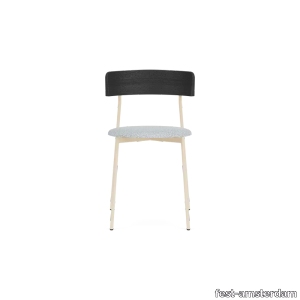
fest-amsterdam > Chair
Dont let its slim appearance fool you. This elegant Friday Dining Chair is solid as a rock. The frame consists of high-quality recycled steel while its back is made of steam-bent solid wood. This design dining chair is available with a small or wide back and its seat comes in black or over 50 fabrics. Choose your favourite and let our craftsmen work their magic
Gaia earthmother.
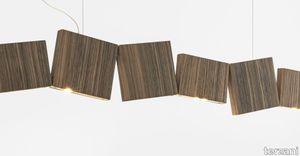
terzani > Ceiling lamp
In Greek mythology, Gaia is the personification of the Earth and the mother of all life. Looking to capture the mythical and natural beauty of this Earth goddess, designer Jean-François Crochet has created the Gaia pendant light. Consisting of geometric frames of brass or raw metal reminiscent of the mountains Gaia created, the pendant uses led light to push light through the “cracks” formed. The resulting light creates a magical feeling, as if the lights peaking through were alive themselves. Also available in gold, nickel and wood finish and in custom configurations, Gaia adds a vibrancy and sacred light to any space. Design Jean-François Crochet. Made in Italy
TROPICO MEDIUM

fontanaarte > Table lamp
The "shape of light" is the central theme of this project by Gabriele and Oscar Buratti, which began with the Equatore family of lamps, presented in 2017 and now expanded to include other finishes, and continues with the new Meridiano and Tropico. Forms of glass and metal that collect, contain and diffuse light in space. Passing between opaline, coloured and transparent layers, emphasised by the refined curves and the magic of blown glass, the light is free to create surprising and fascinating effects, patterns and moods. Tropico is a spherical cap of opaque opaline glass, flattened and fixed by a large mirrored metal boss. The family comprises wall/ceiling and table versions, both available in three different sizes.
Lanna’Table

kdln > Table lamp
A beguiling, lightweight design for a table lamp that is reminiscent of the fascinating tradition of the Lanna. This ancient Thai population used to release hundreds of lanterns into the night sky during festivals. And it is as if one of these had floated down into the most sophisticated and contemporary interiors, recreating the magic with its warm, welcoming light.
EQUATORE SMALL
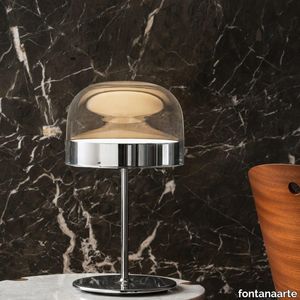
fontanaarte > Table lamp
Equatore is a contemporary reinterpretation of the classic lamp with a glass shade. While the traditional abat-jour uses the shade to contain the light source within, in this family of lamps the shade is paradoxically and suggestively empty, with the light being generated by two luminous discs placed inside a central metal band, visible on the shade, that evokes the line of the equator. The light produced by the Leds, thanks to internal screens arranged in layers, is distributed regularly across the surface of the discs, magically illuminating them. The bottom disc directs the light output downward, the upper one illuminates the glass cap for a soft, diffused light. Available in table, floor and ceiling models, in two sizes and two colors: a cooler version in gray with a dark chrome frame, and a warmer version with a transparent dove gray cap and a copper-colored frame.
EQUATORE SMALL
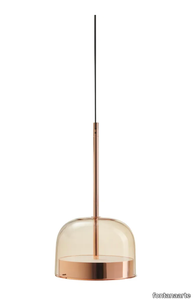
fontanaarte > Ceiling lamp
Equatore is a contemporary reinterpretation of the classic lamp with a glass shade. While the traditional abat-jour uses the shade to contain the light source within, in this family of lamps the shade is paradoxically and suggestively empty, with the light being generated by two luminous discs placed inside a central metal band, visible on the shade, that evokes the line of the equator. The light produced by the Leds, thanks to internal screens arranged in layers, is distributed regularly across the surface of the discs, magically illuminating them. The bottom disc directs the light output downward, the upper one illuminates the glass cap for a soft, diffused light. Available in table, floor and ceiling models, in two sizes and two colors: a cooler version in gray with a dark chrome frame, and a warmer version with a transparent dove gray cap and a copper-colored frame.
Friday dining chair no arms - sand frame - natural back (no upholstery) - Natural
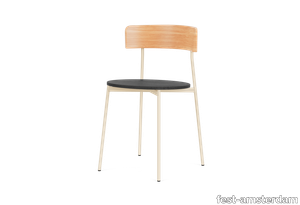
fest-amsterdam > Chair
Dont let its slim appearance fool you. This elegant Friday Dining Chair is solid as a rock. The frame consists of high-quality recycled steel while its back is made of steam-bent solid wood. This design dining chair is available with a small or wide back. Choose your favourite and let our craftsmen work their magic
Friday dining chair with arms - sand frame - natural back (no upholstery) - Natural

fest-amsterdam > Chair
Dont let its slim appearance fool you. This elegant Friday Dining Chair is solid as a rock. The frame consists of high-quality recycled steel while its back is made of steam-bent solid wood. This design dining chair is available with a small or wide back. Choose your favourite and let our craftsmen work their magic
Friday dining chair with arms - sand frame - natural back - Polvere Beige - 21
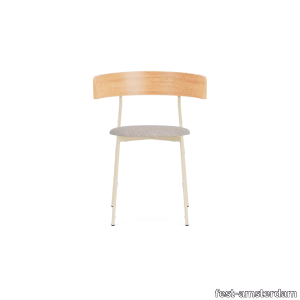
fest-amsterdam > Chair
Dont let its slim appearance fool you. This elegant Friday Dining Chair is solid as a rock. The frame consists of high-quality recycled steel while its back is made of steam-bent solid wood. This design dining chair is available with a small or wide back and its seat comes in black or over 100 fabrics. Choose your favourite and let our craftsmen work their magic
EQUATORE SMALL
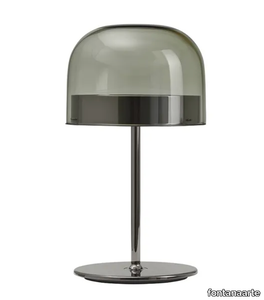
fontanaarte > Table lamp
Equatore is a contemporary reinterpretation of the classic lamp with a glass shade. While the traditional abat-jour uses the shade to contain the light source within, in this family of lamps the shade is paradoxically and suggestively empty, with the light being generated by two luminous discs placed inside a central metal band, visible on the shade, that evokes the line of the equator. The light produced by the Leds, thanks to internal screens arranged in layers, is distributed regularly across the surface of the discs, magically illuminating them. The bottom disc directs the light output downward, the upper one illuminates the glass cap for a soft, diffused light. Available in table, floor and ceiling models, in two sizes and two colors: a cooler version in gray with a dark chrome frame, and a warmer version with a transparent dove gray cap and a copper-colored frame.
MERIDIANO
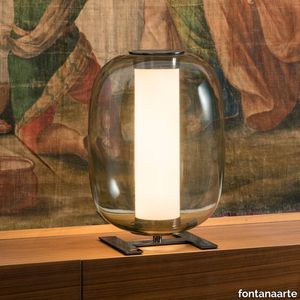
fontanaarte > Table lamp
The "shape of light" is the central theme of this project by Gabriele and Oscar Buratti, which began with the Equatore family of lamps, presented in 2017 and now expanded to include other finishes, and continues with the new Meridiano and Tropico. Forms of glass and metal that collect, contain and diffuse light in space. Passing between opaline, coloured and transparent layers, emphasised by the refined curves and the magic of blown glass, the light is free to create surprising and fascinating effects, patterns and moods. In the new Meridiano lamp, the vertical cylindrical tube contains and diffuses the light in the transparent glass capsule, which defines its refined ovoid shape. Available in two sizes, Meridiano is available as a medium-size and large suspended lamp, to be used individually or in multiples arranged in groups. The table version is offered in the medium size.
MERIDIANO
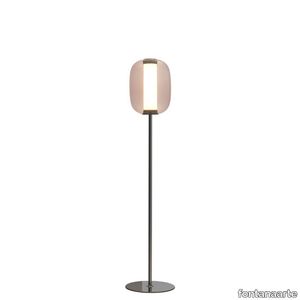
fontanaarte > Floor lamp
The «shape of light» is the central theme of this project by Gabriele and Oscar Buratti, which began with the Equatore family of lamps, presented in 2017 and now expanded to include other finishes, and continues with the new Tropico and Meridiano. The latest family now featuring the new floor-standing version. Forms of glass and metal that collect, contain and diffuse light in space. Passing between opaline, coloured and transparent layers, emphasised by the refined curves and the magic of blown glass, the light is free to create surprising and fascinating effects, patterns and moods.
EQUATORE LARGE
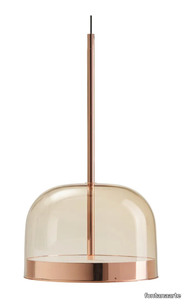
fontanaarte > Ceiling lamp
Equatore is a contemporary reinterpretation of the classic lamp with a glass shade. While the traditional abat-jour uses the shade to contain the light source within, in this family of lamps the shade is paradoxically and suggestively empty, with the light being generated by two luminous discs placed inside a central metal band, visible on the shade, that evokes the line of the equator. The light produced by the Leds, thanks to internal screens arranged in layers, is distributed regularly across the surface of the discs, magically illuminating them. The bottom disc directs the light output downward, the upper one illuminates the glass cap for a soft, diffused light. Available in table, floor and ceiling models, in two sizes and two colors: a cooler version in gray with a dark chrome frame, and a warmer version with a transparent dove gray cap and a copper-colored frame.
EQUATORE SMALL
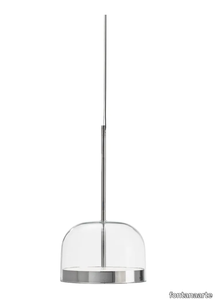
fontanaarte > Ceiling lamp
Equatore is a contemporary reinterpretation of the classic lamp with a glass shade. While the traditional abat-jour uses the shade to contain the light source within, in this family of lamps the shade is paradoxically and suggestively empty, with the light being generated by two luminous discs placed inside a central metal band, visible on the shade, that evokes the line of the equator. The light produced by the Leds, thanks to internal screens arranged in layers, is distributed regularly across the surface of the discs, magically illuminating them. The bottom disc directs the light output downward, the upper one illuminates the glass cap for a soft, diffused light. Available in table, floor and ceiling models, in two sizes and two colors: a cooler version in gray with a dark chrome frame, and a warmer version with a transparent dove gray cap and a copper-colored frame.
MERIDIANO LARGE
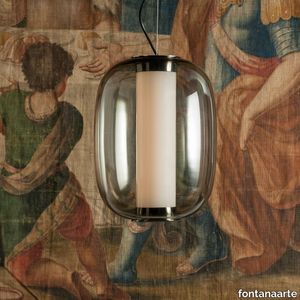
fontanaarte > Ceiling lamp
La “forma della luce” è il tema centrale di questo progetto di Gabriele e Oscar Buratti iniziato con la famiglia di lampade Equatore, presentata nel 2017 ed ora ampliata con altre finiture, fino alle nuove Meridiano e Tropico. Forme di vetro e metallo che raccolgono, contengono e diffondono la luce nello spazio. Passando tra layer opalini, colorati e trasparenti, enfatizzata dalle curvature ricercate e dalla magia dei vetri soffiati, la luce è libera di creare effetti, disegni ed atmosfere sorprendenti ed affascinanti. Nella nuova lampada Meridiano, il tubo cilindrico verticale contiene e diffonde la luce nella capsula di vetro trasparente, che ne definisce la ricercata forma ovoidale. Prevista in due misure, Meridiano è declinata come sospensione media e grande, da usare singolarmente oppure in composizione di multipli disposti a grappolo. La versione da tavolo è proposta nella misura media.
MERIDIANO LARGE
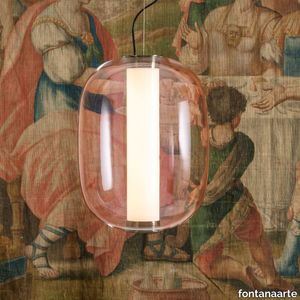
fontanaarte > Ceiling lamp
The "shape of light" is the central theme of this project by Gabriele and Oscar Buratti, which began with the Equatore family of lamps, presented in 2017 and now expanded to include other finishes, and continues with the new Meridiano and Tropico. Forms of glass and metal that collect, contain and diffuse light in space. Passing between opaline, coloured and transparent layers, emphasised by the refined curves and the magic of blown glass, the light is free to create surprising and fascinating effects, patterns and moods. In the new Meridiano lamp, the vertical cylindrical tube contains and diffuses the light in the transparent glass capsule, which defines its refined ovoid shape. Available in two sizes, Meridiano is available as a medium-size and large suspended lamp, to be used individually or in multiples arranged in groups. The table version is offered in the medium size.
MERIDIANO MEDIUM
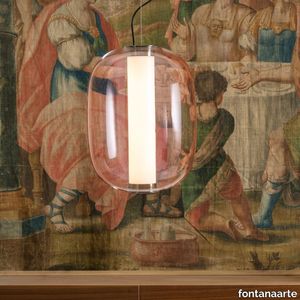
fontanaarte > Ceiling lamp
The "shape of light" is the central theme of this project by Gabriele and Oscar Buratti, which began with the Equatore family of lamps, presented in 2017 and now expanded to include other finishes, and continues with the new Meridiano and Tropico. Forms of glass and metal that collect, contain and diffuse light in space. Passing between opaline, coloured and transparent layers, emphasised by the refined curves and the magic of blown glass, the light is free to create surprising and fascinating effects, patterns and moods. In the new Meridiano lamp, the vertical cylindrical tube contains and diffuses the light in the transparent glass capsule, which defines its refined ovoid shape. Available in two sizes, Meridiano is available as a medium-size and large suspended lamp, to be used individually or in multiples arranged in groups. The table version is offered in the medium size.
SETAREH GLASS MEDIUM
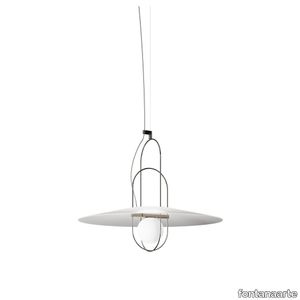
fontanaarte > Ceiling lamp
This is the name of the family of lighting fixtures that Francesco Librizzi, a young Sicilian architect working in Milan, has designed for the first time for FontanaArte. Setareh was born of the idea of giving form to light. The lamp is composed of a sphere magically suspended within a thin metal structure. The play of circular masses and trajectories generates a balanced design of gravitational dynamics. The light from the sphere is diffused into the surrounding space, illuminating the frame. The reflections of the metal render the luminous field visible, space influenced by light, by its aura. The result is a collection of lighting elements, available in tabletop and suspension versions, of extraordinary poetic grace. Setareh takes on new dimensions: elongated, with either two or three spherical elements that work separately or together. Its vocation is the illumination of large spaces, with double-height ceilings or otherwise ample enough to accomodate expansive compositions of multiple elements. A firmament of Setareh, ‘star’ in the ancient Farsi language.
SETAREH MEDIUM

fontanaarte > Ceiling lamp
This is the name of the family of lighting fixtures that Francesco Librizzi, a young Sicilian architect working in Milan, has designed for the first time for FontanaArte. Setareh was born of the idea of giving form to light. The lamp is composed of a sphere magically suspended within a thin metal structure. The play of circular masses and trajectories generates a balanced design of gravitational dynamics. The light from the sphere is diffused into the surrounding space, illuminating the frame. The reflections of the metal render the luminous field visible, space influenced by light, by its aura. The result is a collection of lighting elements, available in tabletop and suspension versions, of extraordinary poetic grace. Setareh takes on new dimensions: elongated, with either two or three spherical elements that work separately or together. Its vocation is the illumination of large spaces, with double-height ceilings or otherwise ample enough to accomodate expansive compositions of multiple elements. A firmament of Setareh, ‘star’ in the ancient Farsi language.
SETAREH SMALL

fontanaarte > Ceiling lamp
This is the name of the family of lighting fixtures that Francesco Librizzi, a young Sicilian architect working in Milan, has designed for the first time for FontanaArte. Setareh was born of the idea of giving form to light. The lamp is composed of a sphere magically suspended within a thin metal structure. The play of circular masses and trajectories generates a balanced design of gravitational dynamics. The light from the sphere is diffused into the surrounding space, illuminating the frame. The reflections of the metal render the luminous field visible, space influenced by light, by its aura. The result is a collection of lighting elements, available in tabletop and suspension versions, of extraordinary poetic grace. Setareh takes on new dimensions: elongated, with either two or three spherical elements that work separately or together. Its vocation is the illumination of large spaces, with double-height ceilings or otherwise ample enough to accomodate expansive compositions of multiple elements. A firmament of Setareh, ‘star’ in the ancient Farsi language.
TROPICO MEDIUM
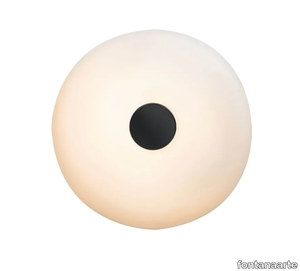
fontanaarte > Wall lamp
The "shape of light" is the central theme of this project by Gabriele and Oscar Buratti, which began with the Equatore family of lamps, presented in 2017 and now expanded to include other finishes, and continues with the new Meridiano and Tropico. Forms of glass and metal that collect, contain and diffuse light in space. Passing between opaline, coloured and transparent layers, emphasised by the refined curves and the magic of blown glass, the light is free to create surprising and fascinating effects, patterns and moods. Tropico is a spherical cap of opaque opaline glass, flattened and fixed by a large mirrored metal boss. The family comprises wall/ceiling and table versions, both available in three different sizes.
TROPICO LARGE
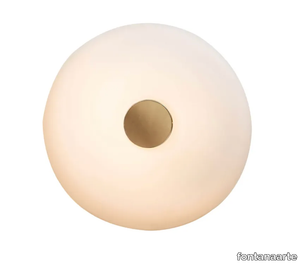
fontanaarte > Wall lamp
The "shape of light" is the central theme of this project by Gabriele and Oscar Buratti, which began with the Equatore family of lamps, presented in 2017 and now expanded to include other finishes, and continues with the new Meridiano and Tropico. Forms of glass and metal that collect, contain and diffuse light in space. Passing between opaline, coloured and transparent layers, emphasised by the refined curves and the magic of blown glass, the light is free to create surprising and fascinating effects, patterns and moods. Tropico is a spherical cap of opaque opaline glass, flattened and fixed by a large mirrored metal boss. The family comprises wall/ceiling and table versions, both available in three different sizes.
TROPICO MEDIUM
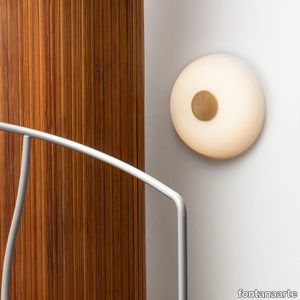
fontanaarte > Wall lamp
The "shape of light" is the central theme of this project by Gabriele and Oscar Buratti, which began with the Equatore family of lamps, presented in 2017 and now expanded to include other finishes, and continues with the new Meridiano and Tropico. Forms of glass and metal that collect, contain and diffuse light in space. Passing between opaline, coloured and transparent layers, emphasised by the refined curves and the magic of blown glass, the light is free to create surprising and fascinating effects, patterns and moods. Tropico is a spherical cap of opaque opaline glass, flattened and fixed by a large mirrored metal boss. The family comprises wall/ceiling and table versions, both available in three different sizes.
TROPICO MEDIUM

fontanaarte > Wall lamp
The "shape of light" is the central theme of this project by Gabriele and Oscar Buratti, which began with the Equatore family of lamps, presented in 2017 and now expanded to include other finishes, and continues with the new Meridiano and Tropico. Forms of glass and metal that collect, contain and diffuse light in space. Passing between opaline, coloured and transparent layers, emphasised by the refined curves and the magic of blown glass, the light is free to create surprising and fascinating effects, patterns and moods. Tropico is a spherical cap of opaque opaline glass, flattened and fixed by a large mirrored metal boss. The family comprises wall/ceiling and table versions, both available in three different sizes.
Gaia earthmother.
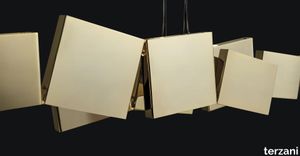
terzani > Ceiling lamp
In Greek mythology, Gaia is the personification of the Earth and the mother of all life. Looking to capture the mythical and natural beauty of this Earth goddess, designer Jean-François Crochet has created the Gaia pendant light. Consisting of geometric frames of brass or raw metal reminiscent of the mountains Gaia created, the pendant uses led light to push light through the “cracks” formed. The resulting light creates a magical feeling, as if the lights peaking through were alive themselves. Also available in gold, nickel and wood finish and in custom configurations, Gaia adds a vibrancy and sacred light to any space. Design Jean-François Crochet. Made in Italy
DropletsLarge on Ceiling Sculpture
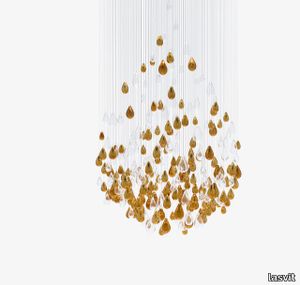
lasvit > Ceiling lamp
Inspired by nature, emotion and a unique frozen moment, this lighting sculpture reminds us of our fascination with water. It captures the perfection of the natural movement when water collects into a drop. The entire composition, as well as the individual elements and their shapes play with the magic of water, air and gravity. The harmonious density gradient highlights this instant, providing sensations of depth and motion.
Cielo Pendant
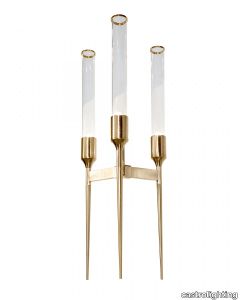
castrolighting > Ceiling lamp
Reveal the power of nature's majesty by inviting it inside your home with the Cielo Collection that has been inspired by nature's magnificence and its wonders - the fusion of pure elements. The Cielo Collection visualizes the concept of natural forces and their mysterious power. The fusion of pure elements – fire, ocean waves, sky, and stones – is the greatest source of inspiration. Fire creates delicacy, wave shapes stones, sky elevates magic, stone brings textures. Therefore, nature shapes lighting design. The Cielo Collection is the dynamic way of conceiving the world and the joy of discovery and wonder. The luxury oasis is waiting, imagine the calcite forms decorations that hang from the ceiling – stalactites with multi-coloured lighting that splits through rocks to glow in the dark. This time, Castro Lighting carries its manufacturing traditions transforming them into contemporary interior aesthetics – a minimal yet artistic expression of the modern lighting design within natural wonders. Brass finishes, textures, glass curves – the customization options are limitless. The Cielo Pendant lamp proudly bears the name which in Italian is related to sky or heaven. This handmade lighting fixture is made of gold-plated brass, the strong lines create an organic movement of subtle brass tubes complementing the luxury chandelier with clear glass. If you look closely enough, the extended tubes remind dangling stalactite and stalagmite shapes. Hammered by the hands of experienced craftsmen, it is capable of transforming the living space into grand adventurous scenery. This finest lighting design is a beautiful addition to complement the hotel lobby, large hallways, long staircases, or the spacious living room. The Cielo handcrafted gold pendant is the perfect choice for the interiors with modern classic style, contemporary vibes, as well as the art-deco touch. Feel the powerful energy of this pendant which brass elements complement the refinement of the interior and permit to reveal a new meaning of beauty. Simplicity, smooth texture, and clean glass lines help define this contemporary lighting design as the signature collection fitting to the most exquisite decors. VIEW FULL FAMILY
Grace Console
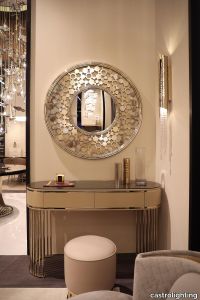
castrolighting > Console
This console carries the same beautiful name and charm that is capable to transform any living space into an outstanding one. The Grace console was designed to be an accent furniture décor to provide a luxurious statement to the interior. The classy decorative piece incorporates bespoke brass elements and a tailor-made poplar root veneer wood top. A sophisticated colour combination is smooth yet delicate – it manifests an effortless elegance that is alluring to decorate with and complete a total home look with balance and harmony. This modern design integrates sleek gold-plated brass lines that are intertwined and create a subtle frame for the upper part of the console table. Create a magical vibe with this versatile lifestyle piece, allowing to beautify a room with various decorative settings and refined home accessories. This handmade furniture design is perfect for a hallway, entryway, living room, dining room, bedroom, or dressing room. Bespoke your dreams with the Grace Console as it can be organically customized and become a central piece for all the lavish houses to help achieve the desired timeless chic. VIEW FULL FAMILY
AXO
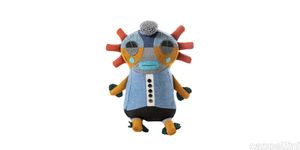
cappellini > Styling
“Children will find the strength and courage to fight to build a better world only if they are able to imagine things that do not exist”, said Gianni Rodari. And this is exactly the inspiration of AXO, a project conceived by Cappellini in collaboration with Elena Salmistraro, presented during Salone del Mobile 2021. AXO is a diminutive of Axolotl, a unique species of salamander with a sort of magical power: the extraordinary ability to recover and regenerate itself.
Pink Vintage Wool Cotton Blend Rug
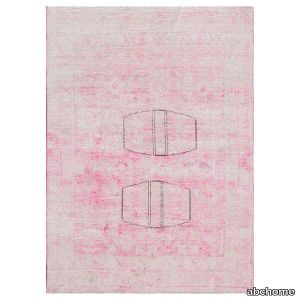
abchome > Carpet
Sourced from the ancient Silk Road to bring a genuine one-of-a-kind rug to your home, this Pink Vintage Wool Cotton Blend Rug - 4'6" x 6' features a soft color palette, distressed finish, and intricate pattern which allows this pink vintage rug to be added to a variety of interiors. Only the finest wool and cotton fibers were used in the creation of this Samarkand rug leaving your bedroom, dining room, or living room with a durable and dense foundation for many years to come. The art of Uzbek carpet weaving originated in ancient times due to Khotan's proximity to the Silk Road making the Samarkand rugs' colors and designs rich with cross-cultural influence from Persia, France, Turkey, India, and China. Antique and vintage Samarkand rugs are exquisite treasures that bear witness to centuries of craftsmanship and cultural heritage.Handcrafted by master artisans dedicated to the artisanal methods of rug making, this vintage rug features patterns passed from mother to daughter with magic symbols including intricate floral motifs, balanced geometrics, and delicate detailing that are designed to protect its owner and bring good luck and prosperity into the home.
Chimera Empatia Bianco
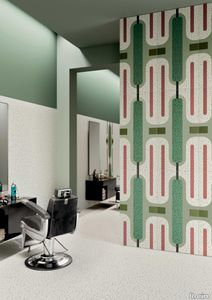
florim > Wall tile-stone-brick
In <em>Chimera,</em> Elena Salmistraro merges rigour with self-expression, in a graphic grammar laden with symbolic meaning. <em>Empatia </em>speaks to the emotions with graphics that interpret, through a highly individual abstract code, the stage make-up of a clown, with the aid of superimposed geometric forms and images. <em>Radici </em>is a tribal statement, a tribute to primitive ritual custom, evoked by the interplay between a sequence of triangles and rectangles and a set of figurative fragments. <em>Ritmo</em> is inspired by fabrics, suggesting the rhythmic alternation of woven yarns through a largely linear pattern. In <em>Colore, </em>the upheaval of a background of small isolated spots generated by a parametric digital program is combined with densely packed repeated forms. "The Chimera collection is rather like a book with four different chapters: I set out to differentiate these graphic motifs to create four totally different stories."<br></br>Elena Salmistraro It all starts with drawing. A <em>passion</em> for drawing. An <em>obsession</em> with drawing. Drawings like spider-webs, obsessively filling spaces, in a kind of manual choreography or gymnastics, a continuous flow. Elena Salmistraro draws all the time. She draws everywhere. Mostly on loose sheets or random surfaces. First and foremost with pen and pencil. Her drawings only acquire colour at a later stage. Often - just like Alessandro Mendini used to do - she draws "monsters": fascinating yet disturbing, subversive forms. The denser, more contorted the shape, the more obvious its underlying truth. For Elena, drawing is an intimate act. It is relaxing. And therapeutic. With an unrivalled communicative strength. Because drawing gives shape to ideas: you both give form to the world and reveal yourself. This passion, combined with natural graphic talent, has guided Elena Salmistraro in her project for Cedit: an experimental series of ceramic slabs produced using a high-definition 3D decorative technique. The explicit aim is to transform surfaces beyond their original flatness so that a new, visual and tactile, three-dimensional personality emerges, sweeping aside the coldness and uniformity that ceramic objects often inevitably convey.Elena Salmistraro has always viewed ceramics as a democratic material, in view of their accessibility, and the infinite potentials for shaping matter that they provide. She began working and experimenting with ceramics very early in her career, just after she graduated from the Milan Politecnico in 2008. She came into contact with small artistic craft firms specialising in smallproduction lots, and cut her teeth on projects that demanded the hand-processing of every detail, and finishes of high artistic value, for the high end of the market. The large corporations and galleries came later, but here again Elena kept faith with her desire to make mass-produced pieces unique, and to combine artistic value with specifically industrial characteristics. The monkey-shaped <em>Primates</em> vases reflect this method and intention, aiming to excite, surprise and charm. Antiminimalist and hyper-figurative, playful, ironic and a rich image-maker, often drawing on anthropology and magic, over the years Salmistraro has built up her own fantastic universe, inhabited by ceramic bestiaries, painted jungles and a cabinet like a one-eyed cyclops , always finding inspiration and inputs in nature and always aiming to reveal the extraordinary in the everyday. Given this background, it was almost inevitable she would work with Cedit: constantly seeking new talents and new approaches, as well as designs that break down the boundaries of ceramics and release them into the realm of art and innovation, the Modena company has recognised Elena Salmistraro as a leading contemporary creative spirit and involved her in a project intended to experiment with fresh ideas in materials and synaesthetics.Salmistraro's collection for Cedit is entitled <em>Chimera</em> and consists of large ceramic slabs, which can be enjoyed not only visually, through their patterns and colours, but also on a tactile level. Like the chimera in the "grotesque" tradition, monstrous in the etymological sense of the word with its merging of hybrid animal and vegetable shapes, the Cedit project attempts to originate a synaesthetic form of ceramics, through a three-dimensional development that exactly reproduces the texture of leathers and fabrics, creating an absolutely new kind of layered effect, with a tactile awareness that recalls the passion of grand master Ettore Sottsass for "surfaces that talk". And the surfaces of the slabs Salmistraro has created really seem to talk: in <em>Empatia </em>clown faces add theatricality to the cold gleam of marbles, interspersed with references to Art Déco graphics; <em>Radici</em> uses the textures of leathers and hide as if to re-establish a link between ceramics and other materials at the origins of human activity and creativity; in <em>Ritmo</em> the texture of cloth dialogues with pottery, almost in homage to the tactile rationalism of warp and weft, of which Bauhaus pioneer Anni Albers was one of the most expressive past interpreters ; finally, <em>Colore</em> has a spotted base generated by computer to underline the contrast between analogue and digital, the graphic sign and the matter into which it is impressed. It is an aesthetic of superimposition and mixing, and especially of synaesthesia: as in her drawings, in the <em>Chimera </em>slabs Elena Salmistraro's art is one of movement and acceleration. A process not of representation but of exploration. Of the world and of oneself. Almost a kind of Zen, for distancing oneself from the world to understand it more fully. In every sense.
Chimera Ritmo Beige

florim > Wallcovering
In <em>Chimera,</em> Elena Salmistraro merges rigour with self-expression, in a graphic grammar laden with symbolic meaning. <em>Empatia </em>speaks to the emotions with graphics that interpret, through a highly individual abstract code, the stage make-up of a clown, with the aid of superimposed geometric forms and images. <em>Radici </em>is a tribal statement, a tribute to primitive ritual custom, evoked by the interplay between a sequence of triangles and rectangles and a set of figurative fragments. <em>Ritmo</em> is inspired by fabrics, suggesting the rhythmic alternation of woven yarns through a largely linear pattern. In <em>Colore, </em>the upheaval of a background of small isolated spots generated by a parametric digital program is combined with densely packed repeated forms. "The Chimera collection is rather like a book with four different chapters: I set out to differentiate these graphic motifs to create four totally different stories."<br></br>Elena Salmistraro It all starts with drawing. A <em>passion</em> for drawing. An <em>obsession</em> with drawing. Drawings like spider-webs, obsessively filling spaces, in a kind of manual choreography or gymnastics, a continuous flow. Elena Salmistraro draws all the time. She draws everywhere. Mostly on loose sheets or random surfaces. First and foremost with pen and pencil. Her drawings only acquire colour at a later stage. Often - just like Alessandro Mendini used to do - she draws "monsters": fascinating yet disturbing, subversive forms. The denser, more contorted the shape, the more obvious its underlying truth. For Elena, drawing is an intimate act. It is relaxing. And therapeutic. With an unrivalled communicative strength. Because drawing gives shape to ideas: you both give form to the world and reveal yourself. This passion, combined with natural graphic talent, has guided Elena Salmistraro in her project for Cedit: an experimental series of ceramic slabs produced using a high-definition 3D decorative technique. The explicit aim is to transform surfaces beyond their original flatness so that a new, visual and tactile, three-dimensional personality emerges, sweeping aside the coldness and uniformity that ceramic objects often inevitably convey.Elena Salmistraro has always viewed ceramics as a democratic material, in view of their accessibility, and the infinite potentials for shaping matter that they provide. She began working and experimenting with ceramics very early in her career, just after she graduated from the Milan Politecnico in 2008. She came into contact with small artistic craft firms specialising in smallproduction lots, and cut her teeth on projects that demanded the hand-processing of every detail, and finishes of high artistic value, for the high end of the market. The large corporations and galleries came later, but here again Elena kept faith with her desire to make mass-produced pieces unique, and to combine artistic value with specifically industrial characteristics. The monkey-shaped <em>Primates</em> vases reflect this method and intention, aiming to excite, surprise and charm. Antiminimalist and hyper-figurative, playful, ironic and a rich image-maker, often drawing on anthropology and magic, over the years Salmistraro has built up her own fantastic universe, inhabited by ceramic bestiaries, painted jungles and a cabinet like a one-eyed cyclops , always finding inspiration and inputs in nature and always aiming to reveal the extraordinary in the everyday. Given this background, it was almost inevitable she would work with Cedit: constantly seeking new talents and new approaches, as well as designs that break down the boundaries of ceramics and release them into the realm of art and innovation, the Modena company has recognised Elena Salmistraro as a leading contemporary creative spirit and involved her in a project intended to experiment with fresh ideas in materials and synaesthetics.Salmistraro's collection for Cedit is entitled <em>Chimera</em> and consists of large ceramic slabs, which can be enjoyed not only visually, through their patterns and colours, but also on a tactile level. Like the chimera in the "grotesque" tradition, monstrous in the etymological sense of the word with its merging of hybrid animal and vegetable shapes, the Cedit project attempts to originate a synaesthetic form of ceramics, through a three-dimensional development that exactly reproduces the texture of leathers and fabrics, creating an absolutely new kind of layered effect, with a tactile awareness that recalls the passion of grand master Ettore Sottsass for "surfaces that talk". And the surfaces of the slabs Salmistraro has created really seem to talk: in <em>Empatia </em>clown faces add theatricality to the cold gleam of marbles, interspersed with references to Art Déco graphics; <em>Radici</em> uses the textures of leathers and hide as if to re-establish a link between ceramics and other materials at the origins of human activity and creativity; in <em>Ritmo</em> the texture of cloth dialogues with pottery, almost in homage to the tactile rationalism of warp and weft, of which Bauhaus pioneer Anni Albers was one of the most expressive past interpreters ; finally, <em>Colore</em> has a spotted base generated by computer to underline the contrast between analogue and digital, the graphic sign and the matter into which it is impressed. It is an aesthetic of superimposition and mixing, and especially of synaesthesia: as in her drawings, in the <em>Chimera </em>slabs Elena Salmistraro's art is one of movement and acceleration. A process not of representation but of exploration. Of the world and of oneself. Almost a kind of Zen, for distancing oneself from the world to understand it more fully. In every sense.
Chimera Radici Grigio

florim > Wallcovering
In <em>Chimera,</em> Elena Salmistraro merges rigour with self-expression, in a graphic grammar laden with symbolic meaning. <em>Empatia </em>speaks to the emotions with graphics that interpret, through a highly individual abstract code, the stage make-up of a clown, with the aid of superimposed geometric forms and images. <em>Radici </em>is a tribal statement, a tribute to primitive ritual custom, evoked by the interplay between a sequence of triangles and rectangles and a set of figurative fragments. <em>Ritmo</em> is inspired by fabrics, suggesting the rhythmic alternation of woven yarns through a largely linear pattern. In <em>Colore, </em>the upheaval of a background of small isolated spots generated by a parametric digital program is combined with densely packed repeated forms. "The Chimera collection is rather like a book with four different chapters: I set out to differentiate these graphic motifs to create four totally different stories."<br></br>Elena Salmistraro It all starts with drawing. A <em>passion</em> for drawing. An <em>obsession</em> with drawing. Drawings like spider-webs, obsessively filling spaces, in a kind of manual choreography or gymnastics, a continuous flow. Elena Salmistraro draws all the time. She draws everywhere. Mostly on loose sheets or random surfaces. First and foremost with pen and pencil. Her drawings only acquire colour at a later stage. Often - just like Alessandro Mendini used to do - she draws "monsters": fascinating yet disturbing, subversive forms. The denser, more contorted the shape, the more obvious its underlying truth. For Elena, drawing is an intimate act. It is relaxing. And therapeutic. With an unrivalled communicative strength. Because drawing gives shape to ideas: you both give form to the world and reveal yourself. This passion, combined with natural graphic talent, has guided Elena Salmistraro in her project for Cedit: an experimental series of ceramic slabs produced using a high-definition 3D decorative technique. The explicit aim is to transform surfaces beyond their original flatness so that a new, visual and tactile, three-dimensional personality emerges, sweeping aside the coldness and uniformity that ceramic objects often inevitably convey.Elena Salmistraro has always viewed ceramics as a democratic material, in view of their accessibility, and the infinite potentials for shaping matter that they provide. She began working and experimenting with ceramics very early in her career, just after she graduated from the Milan Politecnico in 2008. She came into contact with small artistic craft firms specialising in smallproduction lots, and cut her teeth on projects that demanded the hand-processing of every detail, and finishes of high artistic value, for the high end of the market. The large corporations and galleries came later, but here again Elena kept faith with her desire to make mass-produced pieces unique, and to combine artistic value with specifically industrial characteristics. The monkey-shaped <em>Primates</em> vases reflect this method and intention, aiming to excite, surprise and charm. Antiminimalist and hyper-figurative, playful, ironic and a rich image-maker, often drawing on anthropology and magic, over the years Salmistraro has built up her own fantastic universe, inhabited by ceramic bestiaries, painted jungles and a cabinet like a one-eyed cyclops , always finding inspiration and inputs in nature and always aiming to reveal the extraordinary in the everyday. Given this background, it was almost inevitable she would work with Cedit: constantly seeking new talents and new approaches, as well as designs that break down the boundaries of ceramics and release them into the realm of art and innovation, the Modena company has recognised Elena Salmistraro as a leading contemporary creative spirit and involved her in a project intended to experiment with fresh ideas in materials and synaesthetics.Salmistraro's collection for Cedit is entitled <em>Chimera</em> and consists of large ceramic slabs, which can be enjoyed not only visually, through their patterns and colours, but also on a tactile level. Like the chimera in the "grotesque" tradition, monstrous in the etymological sense of the word with its merging of hybrid animal and vegetable shapes, the Cedit project attempts to originate a synaesthetic form of ceramics, through a three-dimensional development that exactly reproduces the texture of leathers and fabrics, creating an absolutely new kind of layered effect, with a tactile awareness that recalls the passion of grand master Ettore Sottsass for "surfaces that talk". And the surfaces of the slabs Salmistraro has created really seem to talk: in <em>Empatia </em>clown faces add theatricality to the cold gleam of marbles, interspersed with references to Art Déco graphics; <em>Radici</em> uses the textures of leathers and hide as if to re-establish a link between ceramics and other materials at the origins of human activity and creativity; in <em>Ritmo</em> the texture of cloth dialogues with pottery, almost in homage to the tactile rationalism of warp and weft, of which Bauhaus pioneer Anni Albers was one of the most expressive past interpreters ; finally, <em>Colore</em> has a spotted base generated by computer to underline the contrast between analogue and digital, the graphic sign and the matter into which it is impressed. It is an aesthetic of superimposition and mixing, and especially of synaesthesia: as in her drawings, in the <em>Chimera </em>slabs Elena Salmistraro's art is one of movement and acceleration. A process not of representation but of exploration. Of the world and of oneself. Almost a kind of Zen, for distancing oneself from the world to understand it more fully. In every sense.
Chimera Radici Beige

florim > Wallcovering
In <em>Chimera,</em> Elena Salmistraro merges rigour with self-expression, in a graphic grammar laden with symbolic meaning. <em>Empatia </em>speaks to the emotions with graphics that interpret, through a highly individual abstract code, the stage make-up of a clown, with the aid of superimposed geometric forms and images. <em>Radici </em>is a tribal statement, a tribute to primitive ritual custom, evoked by the interplay between a sequence of triangles and rectangles and a set of figurative fragments. <em>Ritmo</em> is inspired by fabrics, suggesting the rhythmic alternation of woven yarns through a largely linear pattern. In <em>Colore, </em>the upheaval of a background of small isolated spots generated by a parametric digital program is combined with densely packed repeated forms. "The Chimera collection is rather like a book with four different chapters: I set out to differentiate these graphic motifs to create four totally different stories."<br></br>Elena Salmistraro It all starts with drawing. A <em>passion</em> for drawing. An <em>obsession</em> with drawing. Drawings like spider-webs, obsessively filling spaces, in a kind of manual choreography or gymnastics, a continuous flow. Elena Salmistraro draws all the time. She draws everywhere. Mostly on loose sheets or random surfaces. First and foremost with pen and pencil. Her drawings only acquire colour at a later stage. Often - just like Alessandro Mendini used to do - she draws "monsters": fascinating yet disturbing, subversive forms. The denser, more contorted the shape, the more obvious its underlying truth. For Elena, drawing is an intimate act. It is relaxing. And therapeutic. With an unrivalled communicative strength. Because drawing gives shape to ideas: you both give form to the world and reveal yourself. This passion, combined with natural graphic talent, has guided Elena Salmistraro in her project for Cedit: an experimental series of ceramic slabs produced using a high-definition 3D decorative technique. The explicit aim is to transform surfaces beyond their original flatness so that a new, visual and tactile, three-dimensional personality emerges, sweeping aside the coldness and uniformity that ceramic objects often inevitably convey.Elena Salmistraro has always viewed ceramics as a democratic material, in view of their accessibility, and the infinite potentials for shaping matter that they provide. She began working and experimenting with ceramics very early in her career, just after she graduated from the Milan Politecnico in 2008. She came into contact with small artistic craft firms specialising in smallproduction lots, and cut her teeth on projects that demanded the hand-processing of every detail, and finishes of high artistic value, for the high end of the market. The large corporations and galleries came later, but here again Elena kept faith with her desire to make mass-produced pieces unique, and to combine artistic value with specifically industrial characteristics. The monkey-shaped <em>Primates</em> vases reflect this method and intention, aiming to excite, surprise and charm. Antiminimalist and hyper-figurative, playful, ironic and a rich image-maker, often drawing on anthropology and magic, over the years Salmistraro has built up her own fantastic universe, inhabited by ceramic bestiaries, painted jungles and a cabinet like a one-eyed cyclops , always finding inspiration and inputs in nature and always aiming to reveal the extraordinary in the everyday. Given this background, it was almost inevitable she would work with Cedit: constantly seeking new talents and new approaches, as well as designs that break down the boundaries of ceramics and release them into the realm of art and innovation, the Modena company has recognised Elena Salmistraro as a leading contemporary creative spirit and involved her in a project intended to experiment with fresh ideas in materials and synaesthetics.Salmistraro's collection for Cedit is entitled <em>Chimera</em> and consists of large ceramic slabs, which can be enjoyed not only visually, through their patterns and colours, but also on a tactile level. Like the chimera in the "grotesque" tradition, monstrous in the etymological sense of the word with its merging of hybrid animal and vegetable shapes, the Cedit project attempts to originate a synaesthetic form of ceramics, through a three-dimensional development that exactly reproduces the texture of leathers and fabrics, creating an absolutely new kind of layered effect, with a tactile awareness that recalls the passion of grand master Ettore Sottsass for "surfaces that talk". And the surfaces of the slabs Salmistraro has created really seem to talk: in <em>Empatia </em>clown faces add theatricality to the cold gleam of marbles, interspersed with references to Art Déco graphics; <em>Radici</em> uses the textures of leathers and hide as if to re-establish a link between ceramics and other materials at the origins of human activity and creativity; in <em>Ritmo</em> the texture of cloth dialogues with pottery, almost in homage to the tactile rationalism of warp and weft, of which Bauhaus pioneer Anni Albers was one of the most expressive past interpreters ; finally, <em>Colore</em> has a spotted base generated by computer to underline the contrast between analogue and digital, the graphic sign and the matter into which it is impressed. It is an aesthetic of superimposition and mixing, and especially of synaesthesia: as in her drawings, in the <em>Chimera </em>slabs Elena Salmistraro's art is one of movement and acceleration. A process not of representation but of exploration. Of the world and of oneself. Almost a kind of Zen, for distancing oneself from the world to understand it more fully. In every sense.
Chimera Ritmo Azzurro

florim > Wallcovering
In <em>Chimera,</em> Elena Salmistraro merges rigour with self-expression, in a graphic grammar laden with symbolic meaning. <em>Empatia </em>speaks to the emotions with graphics that interpret, through a highly individual abstract code, the stage make-up of a clown, with the aid of superimposed geometric forms and images. <em>Radici </em>is a tribal statement, a tribute to primitive ritual custom, evoked by the interplay between a sequence of triangles and rectangles and a set of figurative fragments. <em>Ritmo</em> is inspired by fabrics, suggesting the rhythmic alternation of woven yarns through a largely linear pattern. In <em>Colore, </em>the upheaval of a background of small isolated spots generated by a parametric digital program is combined with densely packed repeated forms. "The Chimera collection is rather like a book with four different chapters: I set out to differentiate these graphic motifs to create four totally different stories."<br></br>Elena Salmistraro It all starts with drawing. A <em>passion</em> for drawing. An <em>obsession</em> with drawing. Drawings like spider-webs, obsessively filling spaces, in a kind of manual choreography or gymnastics, a continuous flow. Elena Salmistraro draws all the time. She draws everywhere. Mostly on loose sheets or random surfaces. First and foremost with pen and pencil. Her drawings only acquire colour at a later stage. Often - just like Alessandro Mendini used to do - she draws "monsters": fascinating yet disturbing, subversive forms. The denser, more contorted the shape, the more obvious its underlying truth. For Elena, drawing is an intimate act. It is relaxing. And therapeutic. With an unrivalled communicative strength. Because drawing gives shape to ideas: you both give form to the world and reveal yourself. This passion, combined with natural graphic talent, has guided Elena Salmistraro in her project for Cedit: an experimental series of ceramic slabs produced using a high-definition 3D decorative technique. The explicit aim is to transform surfaces beyond their original flatness so that a new, visual and tactile, three-dimensional personality emerges, sweeping aside the coldness and uniformity that ceramic objects often inevitably convey.Elena Salmistraro has always viewed ceramics as a democratic material, in view of their accessibility, and the infinite potentials for shaping matter that they provide. She began working and experimenting with ceramics very early in her career, just after she graduated from the Milan Politecnico in 2008. She came into contact with small artistic craft firms specialising in smallproduction lots, and cut her teeth on projects that demanded the hand-processing of every detail, and finishes of high artistic value, for the high end of the market. The large corporations and galleries came later, but here again Elena kept faith with her desire to make mass-produced pieces unique, and to combine artistic value with specifically industrial characteristics. The monkey-shaped <em>Primates</em> vases reflect this method and intention, aiming to excite, surprise and charm. Antiminimalist and hyper-figurative, playful, ironic and a rich image-maker, often drawing on anthropology and magic, over the years Salmistraro has built up her own fantastic universe, inhabited by ceramic bestiaries, painted jungles and a cabinet like a one-eyed cyclops , always finding inspiration and inputs in nature and always aiming to reveal the extraordinary in the everyday. Given this background, it was almost inevitable she would work with Cedit: constantly seeking new talents and new approaches, as well as designs that break down the boundaries of ceramics and release them into the realm of art and innovation, the Modena company has recognised Elena Salmistraro as a leading contemporary creative spirit and involved her in a project intended to experiment with fresh ideas in materials and synaesthetics.Salmistraro's collection for Cedit is entitled <em>Chimera</em> and consists of large ceramic slabs, which can be enjoyed not only visually, through their patterns and colours, but also on a tactile level. Like the chimera in the "grotesque" tradition, monstrous in the etymological sense of the word with its merging of hybrid animal and vegetable shapes, the Cedit project attempts to originate a synaesthetic form of ceramics, through a three-dimensional development that exactly reproduces the texture of leathers and fabrics, creating an absolutely new kind of layered effect, with a tactile awareness that recalls the passion of grand master Ettore Sottsass for "surfaces that talk". And the surfaces of the slabs Salmistraro has created really seem to talk: in <em>Empatia </em>clown faces add theatricality to the cold gleam of marbles, interspersed with references to Art Déco graphics; <em>Radici</em> uses the textures of leathers and hide as if to re-establish a link between ceramics and other materials at the origins of human activity and creativity; in <em>Ritmo</em> the texture of cloth dialogues with pottery, almost in homage to the tactile rationalism of warp and weft, of which Bauhaus pioneer Anni Albers was one of the most expressive past interpreters ; finally, <em>Colore</em> has a spotted base generated by computer to underline the contrast between analogue and digital, the graphic sign and the matter into which it is impressed. It is an aesthetic of superimposition and mixing, and especially of synaesthesia: as in her drawings, in the <em>Chimera </em>slabs Elena Salmistraro's art is one of movement and acceleration. A process not of representation but of exploration. Of the world and of oneself. Almost a kind of Zen, for distancing oneself from the world to understand it more fully. In every sense.
Chimera Empatia Nero

florim > Wall tile-stone-brick
In <em>Chimera,</em> Elena Salmistraro merges rigour with self-expression, in a graphic grammar laden with symbolic meaning. <em>Empatia </em>speaks to the emotions with graphics that interpret, through a highly individual abstract code, the stage make-up of a clown, with the aid of superimposed geometric forms and images. <em>Radici </em>is a tribal statement, a tribute to primitive ritual custom, evoked by the interplay between a sequence of triangles and rectangles and a set of figurative fragments. <em>Ritmo</em> is inspired by fabrics, suggesting the rhythmic alternation of woven yarns through a largely linear pattern. In <em>Colore, </em>the upheaval of a background of small isolated spots generated by a parametric digital program is combined with densely packed repeated forms. "The Chimera collection is rather like a book with four different chapters: I set out to differentiate these graphic motifs to create four totally different stories."<br></br>Elena Salmistraro It all starts with drawing. A <em>passion</em> for drawing. An <em>obsession</em> with drawing. Drawings like spider-webs, obsessively filling spaces, in a kind of manual choreography or gymnastics, a continuous flow. Elena Salmistraro draws all the time. She draws everywhere. Mostly on loose sheets or random surfaces. First and foremost with pen and pencil. Her drawings only acquire colour at a later stage. Often - just like Alessandro Mendini used to do - she draws "monsters": fascinating yet disturbing, subversive forms. The denser, more contorted the shape, the more obvious its underlying truth. For Elena, drawing is an intimate act. It is relaxing. And therapeutic. With an unrivalled communicative strength. Because drawing gives shape to ideas: you both give form to the world and reveal yourself. This passion, combined with natural graphic talent, has guided Elena Salmistraro in her project for Cedit: an experimental series of ceramic slabs produced using a high-definition 3D decorative technique. The explicit aim is to transform surfaces beyond their original flatness so that a new, visual and tactile, three-dimensional personality emerges, sweeping aside the coldness and uniformity that ceramic objects often inevitably convey.Elena Salmistraro has always viewed ceramics as a democratic material, in view of their accessibility, and the infinite potentials for shaping matter that they provide. She began working and experimenting with ceramics very early in her career, just after she graduated from the Milan Politecnico in 2008. She came into contact with small artistic craft firms specialising in smallproduction lots, and cut her teeth on projects that demanded the hand-processing of every detail, and finishes of high artistic value, for the high end of the market. The large corporations and galleries came later, but here again Elena kept faith with her desire to make mass-produced pieces unique, and to combine artistic value with specifically industrial characteristics. The monkey-shaped <em>Primates</em> vases reflect this method and intention, aiming to excite, surprise and charm. Antiminimalist and hyper-figurative, playful, ironic and a rich image-maker, often drawing on anthropology and magic, over the years Salmistraro has built up her own fantastic universe, inhabited by ceramic bestiaries, painted jungles and a cabinet like a one-eyed cyclops , always finding inspiration and inputs in nature and always aiming to reveal the extraordinary in the everyday. Given this background, it was almost inevitable she would work with Cedit: constantly seeking new talents and new approaches, as well as designs that break down the boundaries of ceramics and release them into the realm of art and innovation, the Modena company has recognised Elena Salmistraro as a leading contemporary creative spirit and involved her in a project intended to experiment with fresh ideas in materials and synaesthetics.Salmistraro's collection for Cedit is entitled <em>Chimera</em> and consists of large ceramic slabs, which can be enjoyed not only visually, through their patterns and colours, but also on a tactile level. Like the chimera in the "grotesque" tradition, monstrous in the etymological sense of the word with its merging of hybrid animal and vegetable shapes, the Cedit project attempts to originate a synaesthetic form of ceramics, through a three-dimensional development that exactly reproduces the texture of leathers and fabrics, creating an absolutely new kind of layered effect, with a tactile awareness that recalls the passion of grand master Ettore Sottsass for "surfaces that talk". And the surfaces of the slabs Salmistraro has created really seem to talk: in <em>Empatia </em>clown faces add theatricality to the cold gleam of marbles, interspersed with references to Art Déco graphics; <em>Radici</em> uses the textures of leathers and hide as if to re-establish a link between ceramics and other materials at the origins of human activity and creativity; in <em>Ritmo</em> the texture of cloth dialogues with pottery, almost in homage to the tactile rationalism of warp and weft, of which Bauhaus pioneer Anni Albers was one of the most expressive past interpreters ; finally, <em>Colore</em> has a spotted base generated by computer to underline the contrast between analogue and digital, the graphic sign and the matter into which it is impressed. It is an aesthetic of superimposition and mixing, and especially of synaesthesia: as in her drawings, in the <em>Chimera </em>slabs Elena Salmistraro's art is one of movement and acceleration. A process not of representation but of exploration. Of the world and of oneself. Almost a kind of Zen, for distancing oneself from the world to understand it more fully. In every sense.
Chimera Colore Bianco

florim > Wall Paint
In <em>Chimera,</em> Elena Salmistraro merges rigour with self-expression, in a graphic grammar laden with symbolic meaning. <em>Empatia </em>speaks to the emotions with graphics that interpret, through a highly individual abstract code, the stage make-up of a clown, with the aid of superimposed geometric forms and images. <em>Radici </em>is a tribal statement, a tribute to primitive ritual custom, evoked by the interplay between a sequence of triangles and rectangles and a set of figurative fragments. <em>Ritmo</em> is inspired by fabrics, suggesting the rhythmic alternation of woven yarns through a largely linear pattern. In <em>Colore, </em>the upheaval of a background of small isolated spots generated by a parametric digital program is combined with densely packed repeated forms. "The Chimera collection is rather like a book with four different chapters: I set out to differentiate these graphic motifs to create four totally different stories."<br></br>Elena Salmistraro It all starts with drawing. A <em>passion</em> for drawing. An <em>obsession</em> with drawing. Drawings like spider-webs, obsessively filling spaces, in a kind of manual choreography or gymnastics, a continuous flow. Elena Salmistraro draws all the time. She draws everywhere. Mostly on loose sheets or random surfaces. First and foremost with pen and pencil. Her drawings only acquire colour at a later stage. Often - just like Alessandro Mendini used to do - she draws "monsters": fascinating yet disturbing, subversive forms. The denser, more contorted the shape, the more obvious its underlying truth. For Elena, drawing is an intimate act. It is relaxing. And therapeutic. With an unrivalled communicative strength. Because drawing gives shape to ideas: you both give form to the world and reveal yourself. This passion, combined with natural graphic talent, has guided Elena Salmistraro in her project for Cedit: an experimental series of ceramic slabs produced using a high-definition 3D decorative technique. The explicit aim is to transform surfaces beyond their original flatness so that a new, visual and tactile, three-dimensional personality emerges, sweeping aside the coldness and uniformity that ceramic objects often inevitably convey.Elena Salmistraro has always viewed ceramics as a democratic material, in view of their accessibility, and the infinite potentials for shaping matter that they provide. She began working and experimenting with ceramics very early in her career, just after she graduated from the Milan Politecnico in 2008. She came into contact with small artistic craft firms specialising in smallproduction lots, and cut her teeth on projects that demanded the hand-processing of every detail, and finishes of high artistic value, for the high end of the market. The large corporations and galleries came later, but here again Elena kept faith with her desire to make mass-produced pieces unique, and to combine artistic value with specifically industrial characteristics. The monkey-shaped <em>Primates</em> vases reflect this method and intention, aiming to excite, surprise and charm. Antiminimalist and hyper-figurative, playful, ironic and a rich image-maker, often drawing on anthropology and magic, over the years Salmistraro has built up her own fantastic universe, inhabited by ceramic bestiaries, painted jungles and a cabinet like a one-eyed cyclops , always finding inspiration and inputs in nature and always aiming to reveal the extraordinary in the everyday. Given this background, it was almost inevitable she would work with Cedit: constantly seeking new talents and new approaches, as well as designs that break down the boundaries of ceramics and release them into the realm of art and innovation, the Modena company has recognised Elena Salmistraro as a leading contemporary creative spirit and involved her in a project intended to experiment with fresh ideas in materials and synaesthetics.Salmistraro's collection for Cedit is entitled <em>Chimera</em> and consists of large ceramic slabs, which can be enjoyed not only visually, through their patterns and colours, but also on a tactile level. Like the chimera in the "grotesque" tradition, monstrous in the etymological sense of the word with its merging of hybrid animal and vegetable shapes, the Cedit project attempts to originate a synaesthetic form of ceramics, through a three-dimensional development that exactly reproduces the texture of leathers and fabrics, creating an absolutely new kind of layered effect, with a tactile awareness that recalls the passion of grand master Ettore Sottsass for "surfaces that talk". And the surfaces of the slabs Salmistraro has created really seem to talk: in <em>Empatia </em>clown faces add theatricality to the cold gleam of marbles, interspersed with references to Art Déco graphics; <em>Radici</em> uses the textures of leathers and hide as if to re-establish a link between ceramics and other materials at the origins of human activity and creativity; in <em>Ritmo</em> the texture of cloth dialogues with pottery, almost in homage to the tactile rationalism of warp and weft, of which Bauhaus pioneer Anni Albers was one of the most expressive past interpreters ; finally, <em>Colore</em> has a spotted base generated by computer to underline the contrast between analogue and digital, the graphic sign and the matter into which it is impressed. It is an aesthetic of superimposition and mixing, and especially of synaesthesia: as in her drawings, in the <em>Chimera </em>slabs Elena Salmistraro's art is one of movement and acceleration. A process not of representation but of exploration. Of the world and of oneself. Almost a kind of Zen, for distancing oneself from the world to understand it more fully. In every sense.